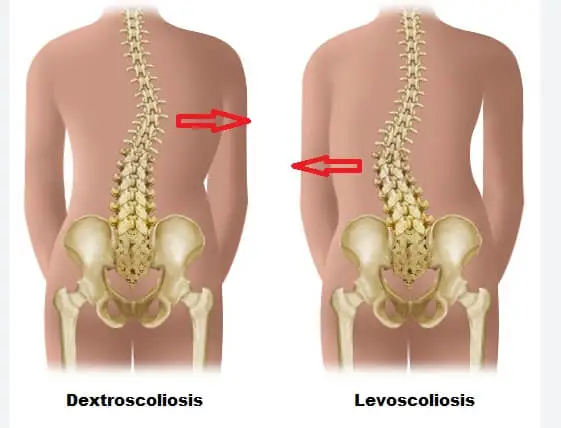
背骨は、歩く、座る、捻る、曲げるなど、身体の様々な活動を支える重要な柱である。その独特な構造は、横から見ると優雅な「S」の字を描き、首と腰は内側に反る前弯カーブ、背中中部は外側に反る後弯カーブを描く。
しかし、脊柱側弯症という、異常な側湾を経験する人もいる。この状態は、1つまたは複数のカーブに影響を及ぼし、様々な不快感をもたらす可能性があるため、特別な注意と治療が必要となります。ここでは、脊柱側湾症の2つの一般的なタイプであるレボスコリオーシスとデキストスコリオーシスに焦点を当て、それぞれの違い、原因、症状、治療法について説明します。
何をするのか? レボスコリオーシスと伸側弯症?
背骨の理想的な状態は、垂直でバランスが取れている状態ですが、中には横への湾曲が見られる場合があり、レボスコリオーシスやデキストスコリオーシスとなります。どちらも脊柱側弯症に分類され、横から見たときの異常な側湾が特徴です。
脊柱側弯症 一方、腰椎の除弯症は右側に弯曲する。これらの湾曲は脊椎の様々な部位で起こり得ますが、伸側弯症は主に胸椎に現れます。
脊椎の湾曲は、脊椎骨の異常な回転と側屈を伴い、脊椎の垂直方向のバランスを崩します。レボスコリオーシスと外反スコリオーシスは一般的に徐々に進行し、時間とともに湾曲が強くなります。
このような湾曲は見た目には気づきにくいかもしれないが、さまざまな不快感や症状を引き起こし、個人の生活に影響を与える可能性がある。
レボスコリオーシスと伸側弯症の原因
レボスコリオーシスと伸側弯症の発生には、遺伝、生理学的変化、環境の影響など、さまざまな要因が絡み合っており、これらの脊柱湾曲の独特な特徴に寄与している。
レボスコリオーシスと伸側湾症の発症には、遺伝的要因が極めて重要な役割を果たしている。研究によると、家族性の関連性が示唆されており、家族の一人が脊椎側湾症であれば、他の家族も影響を受けやすい可能性がある。症例の80%を占める特発性脊柱側湾症は、これらの湾曲を引き起こす特定の遺伝子やメカニズムがまだ解明されていないことを意味している。
生理的な要因もまた、湾曲の発生に影響を及ぼしうる。特に加齢による脊椎の退行性変化や磨耗は、脊椎の不規則な動きを引き起こし、最終的に湾曲に至ることがある。これらの要因が遺伝的要素と絡み合うことで、背骨の構造に異常が生じることがよくあります。
脊椎腫瘍、神経筋疾患、結合組織疾患は、レボスコリオーシス胸腰部脊柱側弯症や伸側弯症の潜在的な原因である。腫瘍は脊椎の構造に影響を与え、神経筋疾患は筋肉のバランスを崩し、側湾の原因となります。線維筋痛症のような結合組織疾患は軟部組織に影響を与え、脊椎の安定性を損なうことがあります。
このような湾曲の発生は、人生の初期段階に限られるものではなく、青年期や成人期に起こることもある。 先天性側弯症 そして 若年性側湾症脊椎湾曲症は、出生時または3~9歳の間に発症することが一般的である。しかし、背骨の湾曲は、遺伝、環境的要素、生活習慣などの無数の要因の影響を受けて、思春期や成人期にも現れることがある。
レボスコリオーシスと伸側弯症の症状と診断
レボスコリオーシスと伸側湾症の症状は様々ですが、初期段階では目立たないという共通点があります。青少年の場合、症状は軽く、背骨の湾曲に気づかないこともあります。症状が進行するにつれて、徴候や症状が徐々に明らかになります。
レボスコリオーシスと伸側弯症の患者は、一般的に慢性的な背部痛を経験する。この痛みは背骨の曲がった部分に限局していることが多く、特に長時間座ったり立ったりした後に生じます。また、特に思春期の患者においては、身体の変化に対する不快感から感情の起伏が激しくなり、不安が生じることもあります。
特に湾曲が胸椎に影響を及ぼすと、呼吸器の問題が現れることがある。この圧迫は肺機能に影響を与え、呼吸障害を引き起こす可能性がある。側湾によって胸部が非対称になるため、肋骨の変形は比較的よく見られます。
このような一般的な症状に加えて、レボスコリオーシスと脱力側弯症は、感覚喪失、筋制御の弱体化、さらには膀胱や腸の機能の制御障害など、さまざまな神経学的問題を引き起こす可能性があります。これらの症状には個人差があり、症状の重さも患者さんによって異なります。
レボスコリオーシスと伸側弯症の診断の鍵は、専門家による脊椎の評価にあります。専門医は、背骨の回転を測定するために、大工の水平器のような「スコリオメーター」を利用します。前屈テストでは、患者は腕を垂らし、背中を床と平行にした状態で腰を曲げ、スコリオメーターは背骨のねじれを測定します。
回転が明らかな場合は、通常、X線検査が行われる。 コブ角湾曲の程度を示す。軽度の側弯症は10度から20度、中等度は20度から40度で、コブ角が40度を超えると重度の側弯症となります。
これらの診断ツールは、レボスコリオーシスかデキストスコリオーシスかを判断し、湾曲の程度を測定することで、患者の脊椎の状態に関する包括的な洞察を提供します。これは、その後の治療計画を立てるための重要な基礎となり、患者が最適な医療を受けられるようにします。
レボスコリオーシスと伸側弯症の治療法
レボスコリオーシス治療と脊柱管狭窄症治療は、症状を緩和し、さらなる湾曲の進行を防ぎ、患者の全体的な生活の質を高めることを目的としています。治療法の選択は通常、脊柱湾曲の重症度、患者の年齢、そして全身の健康状態によって決まります。
ストレッチ、エクササイズ、理学療法: 軽度から中等度のレボスコリオーシスと除脊柱側湾症には、ストレッチ、運動、理学療法が外科手術以外の治療法として好まれることが多い。これらのアプローチは、脊椎周囲の支持筋を強化し、姿勢を改善し、症状を緩和し、側湾のさらなる進行を防ぐことを目的としています。専門家の指導の下での定期的な運動は、患者が脊椎の柔軟性と安定性を維持するのに役立ちます。
ブレーシング: 成長期の患者、特に思春期の患者には、装具は効果的な治療オプションとなりうる。歯列矯正は、背骨の側方への湾曲を制限するためにデザインされた、カスタマイズされたサポーターです。この治療法には通常、医療専門家による監督と、症状の進行や患者の成長に応じた調整が必要です。
脊椎固定術: レボスコリオーシスと伸側弯症の重症例、特に湾曲が40度を超える場合、脊椎固定術が考慮されます。この手術は、脊椎の関連する骨をつなぎ合わせ、一つの構造に融合させることで、症状を緩和し、さらなる湾曲を防ぐものです。術後は通常、リハビリテーションや理学療法を受け、徐々に回復していきます。
定期的なフォローアップ どのような治療法が選択されたとしても、レボスコリオーシスとデキストスコリオーシスの患者は、通常、定期的な経過観察が必要です。これにより、医師は湾曲の変化をモニターし、治療計画を調整し、患者の全体的な健康状態を良好に保つことができます。
治療計画は、各患者の特定の状況に合わせた個別化されたものであるべきであることを強調することは極めて重要である。医療専門家は、年齢、湾曲の程度、全体的な健康状態などの要素を考慮し、患者のニーズに最も適した治療計画を考案します。
同時に、患者とその家族のサポートも不可欠である。治療過程を理解し、リハビリテーション活動に積極的に参加し、医学的アドバイスを守ることは、患者のQOL向上に大きく貢献する。
レボスコリオーシスと伸側弯症がもたらす課題に直面して、 先見の明 は、医療分野における先駆的なベンチマークとしての地位を確立し、患者さんに充実した治療の選択肢を提供しています。当院の製品にご興味のある方は、患者さんへの説明ときめ細かなサービスをお約束します。
参考文献
- 全米側湾症財団."レボスコリオーシスと伸側弯症を理解する".にて入手可能: https://www.scoliosis.org/
- メイヨークリニック.「脊柱側湾症:症状と原因".にて入手可能: https://www.mayoclinic.org/
- 米国整形外科学会(AAOS).「脊柱側湾症のための装具で入手可能: https://www.aaos.org/
- 側湾症研究協会(SRS).「脊柱側湾症の治療法にて入手可能: https://www.srs.org/
- クリーブランド・クリニック.「脊柱側湾症の診断と治療".にて入手可能: https://my.clevelandclinic.org/

